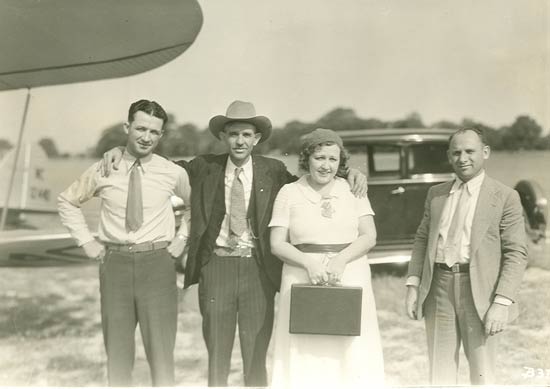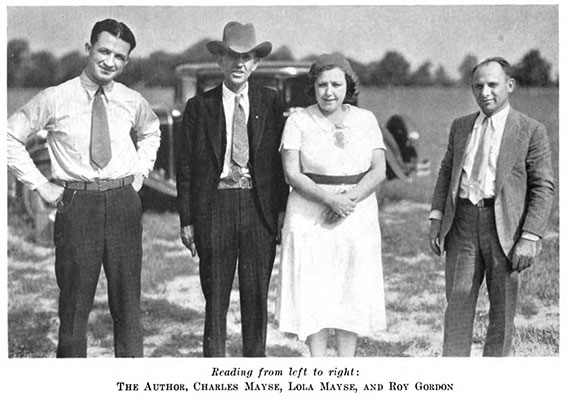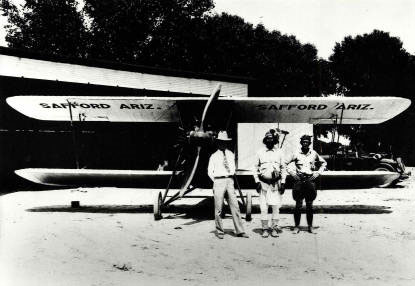|
Charles W. "Charley" Mayse was a frequent signer of the
Davis-Monthan Airfield Register. His signature, and those
of his passengers, including Ernest Wickersham, below, appears ten times between February 15,
1926 and May 8, 1932. It is surprising that his name doesn't
appear more frequently, as he was a local Tucson aviator
who operated out of our Airfield and gave flight instruction
there.
In the image above, Mayse is to the left, behind Santa Claus,
in this photo taken in 1923 at Douglas, AZ. The Shell Oil
Company provided candy for the local children in exchange
for advertising on the lower wing of Mayse's Hisso Standard.
The image, below, shows Mayse in Stetson hat. The date of
the image is probably near June1932 (see below). Image courtesy of dmairfield.org friend, Andy Heins. The aircraft in the background is a Waco
cabin-type, which Mayse had sold to the McElroys, and may be NC12440 (see below).
L to R, Clarence McElroy, Charles Mayse and wife,
Lola, and Roy Gordon
 |
Below, another photograph of the same people dated ca. June 1932 exhibited in a book from the HathiTrust titled "Seventeen Days in the Mexican Jungle" written by McElroy. Roy Gordon had purchased two Waco cabin airplanes (NC12440 & NC12474) for his transportation business, Empressa Dean, Tegucigalpa, Honduras. See page 51 of the linked publication for a picture of "Empressa Dean," which was a ferry boat and company namesake. Also from the link (via Google Translate), "It was also the first company that in addition to the vehicle fleet, also had the first “ferry‐boat” that allowed to save the crossing of Lake Yojoa without transferring from one car to another. In addition to the public transport service, the company also offered cars in Ford brand sale, and additionally sold parts and accessories such as tires and oils."
L to R, Clarence McElroy, Charles Mayse and wife,
Lola, and Roy Gordon (Source: Link)
 |
Gordon contracted McElroy to fly NC12474 south from the Waco factory to Detroit, MI to Honduras. NC12474 crashed in Mexico killing Gordon. McElroy survived and the circumstances of McElroy's life leading up to and after the crash were the subject matter for his book. Mayse flew NC12240 carrying his wife as passenger. There was a third Waco, too, which was owned by Mayse that he left in Brownsville,TX and picked up after the ferry flight. McElroy's book is a page-turner, ripping yarn and is imminently readable at the link. He survived seventeen days in mountainous jungle with laceations and an injured hip. Thanks to Guest Editor Bob Woodling for researching McElroy's book.
To continue, it is interesting to note that at least three of Mayse's landings at Tucson were greeted with inspections by the U.S. Border Patrol. In the Remarks column of the Register appears the notation, "Inspected Robert R. Budlong Patrol Inspector". No reason was given for the inspections, nor was any apparent, given that Mayse's itineraries on these flights were not trans-border.
At left, an early article in the Tucson Citizen of November
1, 1925 describes pilot Mayse giving an airplane ride to
a local cattleman. This article precedes by just a few months
the first signing of the Register by Mayse (on February 15, 1926).
The
"Standard airplane" referred to in the article
is most likely the one Mayse landed with on February 15, 19/26 and
on March 1, 1926. At this time, the Airfield
was at its South 6th Avenue location (on the corner of Irvington
Rd.). The Standard could also be the one pictured above.
At the time of this article, Mayse "is back .... to
remain in Tucson for the winter...." from his home in
Salt Lake City, UT. W.C. Maus, mentioned in the article, only
shows up in the Register once as a passenger with Glover Johns
years later, sometime between early April and mid-May 1934.
Maus died shortly thereafter. According to a site visitor, he seems to have been the victim of the November 9, 1935 crash of Braniff's Vega 5C NC980Y (not a Register airplane). The report on the crash is in the Embry-Riddle archive only, not the DOT archive. It lists the pilot as "William C. Maus of Waco, Texas". This was a nighttime ferry flight with no passengers. Visibility got extremely bad, and for some reason Maus apparently tried to attempt a landing rather than fly to a field with better conditions. In the process, he dived the airplane into the ground.
There wasn't a whole lot going on at the Tucson Airfield during
these years. Another article from the Citizen, dated July
28, 1927, cites the purchase of an aircraft by local linotype
operator, E.R. Griswold (didn't sign the Register). The article
states, "With this plane on the ground, the number will
be exactly two...." airplanes on the field. The relevance
of this article is that Griswold was not a pilot, and, "...he
admits that the intricacies of an airplane are still a mystery
to him, but he hopes to solve these under the tutelage of
Carl [sic] Mayse this fall. Mayse is a professional in the
air game, and has been teaching aviation for a number of years,
along with his commercial flying."
In another article published in the Tucson Citizen on October
14, 1927, Mayse and Gilbert
Sykes, a parachute jumper and
a pilot whom Mayse had taught to fly, are found flying and
jumping at an air show at Duncan, AZ.
By one account (Abbey reference, left sidebar) Mayse was undereducated,
profane, opinionated, sexist and impulsive. But enough flattery.
The life he carved absorbed these shortcomings and left him
a well-known character in southwest Golden Age aviation.
He is mentioned numerous times in the Reinhold reference,
left sidebar.
His
ownership of Curtiss Oriole 2728 demonstrated
his impulsiveness, with a modest regard for aviation safety.
For that Oriole he, “remodeled
the engine section with steel tubing, put on DeHavilland
axle and widened the wheel tread (750x125 wheels-900x200
tires). Put on wind-driven gasoline pump from Martin bomber.”
Mayse died on July 4, 1950, at age 64 (although I have seen
notation that his birth was during 1889, which would have
made him 61), in Douglas, AZ where he had moved in 1935 to
operate that city's municipal airport and a flight training
school. He also operated private charter flights into Mexico
and was a sales representative for Waco aircraft (see NC863V. This airplane was brokered by Mayes, and is still flying as of June 15, 2010).
Ernest Wickersham, Chief Cintotie of the San Carlos Apaches and Charlie Mayse with Wickersham's J-5 Waco in Safford, AZ (Source: ASL)
 |
At right, from the Arizona State Library (ASL) collection, are Ernie Wickersham, Chief Cintotie of the San Carlos Apaches and Charlie Mayse with Wickersham's J-5 Waco in Safford, AZ just before Mayse took, off for the Transcontinental Air Tour. It wasn't clear from the ASL what Air Tour was referred to in the photo caption. Mayes was not among the list of participants in the 1928 National Air Tour (Ford Reliability Tour), which did pass through Tucson that year.
Wickersham landed once at Tucson as pilot in command on March 16, 1926. He landed as a passenger with Mayse on half of his ten landings at Tucson. I have no other information about Wickersham. If you can help, please let me KNOW.
---o0o---
Mayse was inducted into the Arizona Aviation Hall of Fame in 1992. A brief bigraphical sketch appears at the Web site of the Pima Air & Space Museum, Tucson, AZ as follows:
Charles Mayse was born near Pawhuska, Oklahoma. He left school at the age of twelve and worked at odd jobs until serving as a truck driver for the Pershing Expedition in 1916. Later, he learned to fly and purchased a JH-4 in which he barnstormed throughout the midwest. He flew in Chihuahua, Mexico for the Rurales in 1920 before returning to barnstorming in the U.S. Charley flew mail for a time in Honduras, but illness forced a return once again to barnstorming. In 1927 he leased the old Tucson Municipal Airport and opened the Mayse Flying School. The Mayse Air Service provided flying instruction, airplane sales, and charter flights.
During the Depression, Charley flew charter flights from Sky Harbor in Phoenix. He took over the Douglas, Arizona International Airport in 1935 but left to train military pilots during World War II. Returning to Douglas, Charley resumed the job he had left during the war. Charley Mayse blazed a trail in the Arizona skies for others to follow. No other person did more to put Arizona at the forefront of aircraft safety and pilot training.
|
---o0o---
Dossier 2.1.25
UPLOADED: 03/01/06 REVISED: 05/03/07, 11/18/08, 06/15/10, 01/02/14, 01/12/20
|






